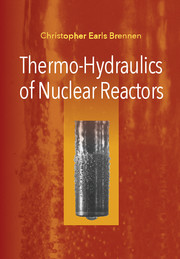2 - Basic Nuclear Power Generation
Published online by Cambridge University Press: 05 April 2016
Summary
Nuclear Power
Nuclear energy is released when atoms are either split into smaller atoms (a phenomenon known as fission) or combined to form a larger atom (a phenomenon known as fusion). This monograph will focus on the production of power by harnessing atomic fission since that is the principle process currently utilized in man-made reactors.
Most of the energy produced by nuclear fission appears as heat in the nuclear reactor core, and this heat is transported away from the core by conventional methods, namely, by means of a cooling liquid or gas. The rest of the power generation system is almost identical in type to the way in which heat is utilized in any other generating station, whether powered by coal, oil, gas, or sunlight. Often the heat is used to produce steam that is then fed to a steam turbine that drives electric generators. In some plants, hot gas rather than steam is used to drive the turbines. In the case of steam-generating nuclear power plants, the part of the plant that consists of the reactor and the primary or first-stage cooling systems (pumps, heat exchangers, etc.) is known as the nuclear steam supply system, and the rest, the conventional use of the steam, is called the balance of plant. This monograph does not deal with this conventional power generation technology but focuses on the nuclear reactor, its production of heat, and the primary coolant loop that cools the reactor core.
Nuclear Fuel Cycle
Though it is possible that power might be derived from nuclear fusion at some point in the distant future, all presently feasible methods of nuclear power generation utilize the energy released during nuclear fission, that is to say, the process by which a neutron colliding with an atom causes that atom to split and, as a by-product, produces heat. With atoms known as fissile atoms, additional neutrons are released at the same time, thus allowing a continuing, naturally regenerating process of fission and a source of heat. The only naturally occurring fissile material is the uranium isotope, 235U, but it only occurs along with a much greater quantity of the common isotope, 238U. Specifically, naturally occurring uranium contains 99.29 percent of 238U and only 0.71 percent of 235U (138 atoms of 238U for every atom of 235U).
- Type
- Chapter
- Information
- Thermo-Hydraulics of Nuclear Reactors , pp. 5 - 24Publisher: Cambridge University PressPrint publication year: 2016

